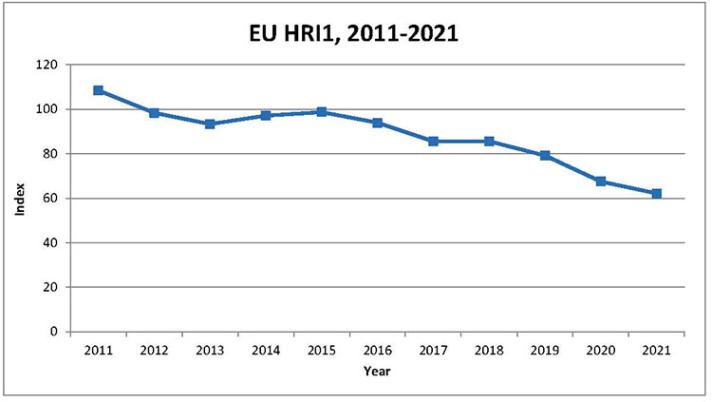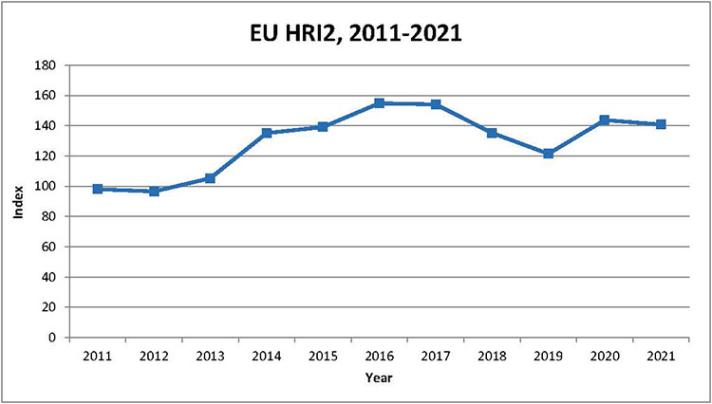Commission publishes updated pesticide risk indicators for 2021
On 30 August 2023, the Commission published updated EU Harmonised Risk Indicators for pesticides for the period 2011-2021 for the EU. These indicators are important because they show the trends in the risks associated with the use of pesticides since 2011 under Directive 2009/128/EC.
Harmonised Risk Indicator 1 (HRI 1), measuring the use and risk of pesticides, shows a decrease of 38% since the baseline period in 2011-2013 and a 6 percentage point decline compared to 2020.
Harmonised Risk Indicator 2 (HRI 2), which is based on the number of emergency authorisations, shows an increase of 41% since the baseline period in 2011-2013 and a 3 percentage point decrease compared to 2020.
These results show continuing progress in risk reduction and support the achievement of the Farm to Fork pesticide reduction targets.
On 22 June 2022, the Commission published a proposal for a new Regulation on the Sustainable Use of Plant Protection Products, replacing Directive 2009/128/EC. The new Regulation contains a range of actions including establishing mandatory Union and national targets in line with the Farm the Fork strategy.
In addition, the Commission will continue to;
- ensure the full implementation of existing EU rules on pesticides by Member States (including launching infringement actions if necessary);
- ensure that Member States undertake the necessary evaluations of the trends in Harmonised Risk Indicators 1 and 2;
- ensure that Integrated Pest Management (IPM) is fully implemented;
- ensure that, under the Common Agricultural Policy (CAP), the Member States Strategic Action Plans show a high level of ambition regarding pesticides.
Background information
The Commission published Harmonised Risk Indicators (HRI 1 and 2) for the first time in 2019, for the period 2011-2017.
HRI 1 is based on data on pesticide sales reported to the Commission by Member States under Regulation (EC) No 1185/2009.
HRI 2 is based on the number of emergency authorisations reported to the Commission by Member States using the E-Submission Food Chain (ESFC) Platform, which replaced the Plant Protection Management System (PPPAMS) in January 2023. The indicators are calculated using the methodology laid down in Annex IV of Directive 2009/128/EC.
Member States are obliged to calculate and publish the trends in HRIs 1 and 2 for the 2011-2021 period by 30 August 2023, and to notify the Commission where this information is published. Details of the trends in HRI 1 and 2 for each Member State are available.
Graph 1. Harmonised Risk Indicator 1
Harmonised Risk Indicator 1 is calculated by multiplying the quantities of active substances placed on the market in plant protection products by a weighting factor.
For practical purposes, active substances are grouped into four categories, in line with Regulation (EC) No 1107/2009. The weightings applied to each category are intended to reflect policy on the use of pesticides and to support the goal of the Sustainable Use of Pesticides Directive to reduce the risk and impact of pesticide use and promote alternative approaches or techniques.
A baseline of the average of three years 2011-2013 is used as the starting point against which subsequent values are compared.
Harmonised Risk Indicator 1 shows a 38% reduction in the risk to human health and the environment from pesticides in the European Union in the period from 2011 to 2021, and a 6 percentage point decline compared to 2020.
Graph 2. Harmonised Risk Indicator 2
Harmonised Risk Indicator 2 is calculated by multiplying the number of emergency authorisations granted by Member States under Article 53 of Regulation (EC) No 1107/2009 by a weighting factor.
As with Harmonised Risk Indicator 1, active substances are grouped into four categories, and weightings are applied to each category. A baseline of the average of three years, 2011-2013 is used as the starting point against which subsequent values are compared.
Harmonised Risk Indicator 2 for the European Union shows a 41% increase in the period from 2011 to 2021, and a 3 percentage point decrease compared to 2020.
Emergency authorisations are granted for a wide range of reasons, including emerging plant health issues and minor uses, as defined by Article 3(26) of Regulation (EC) No 1107/2009, and reported to the Commission using the E-Submission Food Chain (ESFC) Platform. Since February 2020, the Commission publishes all notifications of emergency authorisations.
Up to this point, it has not been possible to establish a more sophisticated HRI 2 as only a limited number of Member States have recorded the scale of these authorisations. However, the guidance on emergency authorisations was updated with effect from 1 March 2021, so that Member States are now required to report the area treated in each case.
The Commission’s proposal for a new Regulation on the Sustainable Use of Plant Protection Products includes a modified HRI 2, which will include this new data to reflect better the risks linked to emergency authorisations.
The Commission is concerned about the increasing number of emergency authorisations being granted by Member States, and the consequent trend in HRI 2 and is closely monitoring these authorisations. For example, the Commission has initiated action on emergency authorisations granted repeatedly by Member States for plant protection products containing neonicotinoid active substances. Further information on the steps taken by Commission can be found here.
In addition to the harmonised risk indicators for the EU, each Member State is obliged to calculate and publish the Harmonised Risk Indicators for their territory.
Trends in Sales
The Commission has published data on The quantities of active substances placed on the market in different types of PPPs. The data was published for the first time in 2022, covering the period 2011-2019, and will be updated annually.


